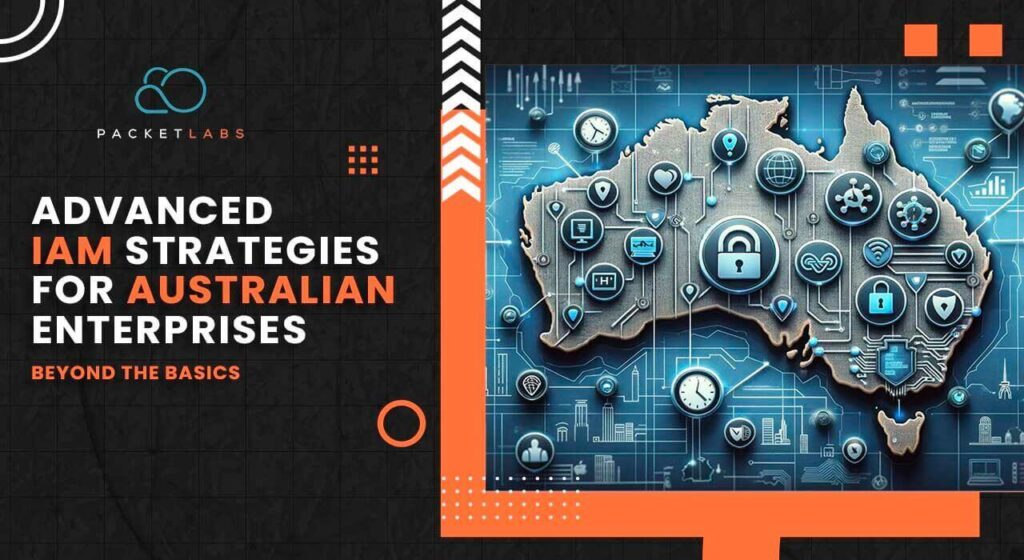
The Australian business landscape is undergoing a significant digital transformation, with organisations increasingly reliant on interconnected systems and sensitive data. This rapid evolution, however, necessitates a robust Identity and Access Management (IAM) strategy to navigate the ever-growing complexities of the contemporary security landscape.
According to the Australian Cyber Security Centre (ACSC), cybercrime cost Australian businesses an estimated $6 billion in 2021-2022 alone, highlighting the crucial need for comprehensive security measures. While basic IAM solutions, like static role-based access control, may suffice for smaller organisations, larger enterprises with intricate IT infrastructures and diverse user bases require a more sophisticated approach. Enter “beyond the basics” IAM – a strategic framework designed to address the unique challenges faced by these complex entities.
Packetlabs understands the critical role of advanced IAM in securing sensitive information and maintaining operational efficiency. With extensive expertise in this domain, Packetlabs empowers Australian enterprises to implement robust and scalable IAM solutions, ensuring a secure and compliant digital environment.
The Evolving Threat Landscape in Australia

The Australian business landscape is not immune to the ever-evolving tapestry of cyber threats. According to the Australian Cyber Security Centre (ACSC)’s “Australian Cyber Security Incident Trends Report 2022″, ransomware attacks have become the most reported cybercrime in Australia, impacting businesses of all sizes. This concerning trend exemplifies the increasing sophistication and persistence of cyber adversaries, necessitating a proactive approach to cybersecurity.
These evolving threats pose unique challenges for enterprises with complex IT infrastructure and diverse user populations. Managing access controls across multiple systems, applications, and user groups becomes increasingly intricate in such environments. Additionally, the presence of legacy systems, third-party integrations, and remote workforces further amplifies the attack surface, creating potential vulnerabilities that malicious actors can exploit. The ability to effectively manage user identities and access privileges becomes paramount in mitigating these risks and ensuring the overall security posture of the organization.
Limitations of Basic IAM Approaches

While essential building blocks, fundamental IAM solutions like static Role-Based Access Control (RBAC) present limitations for complex organizations. RBAC pre-assigns access based on predefined roles, which can become cumbersome and inefficient when managing diverse user populations with varying access requirements across numerous systems and applications. This inflexibility can lead to security vulnerabilities, as users may be granted excessive or insufficient privileges, increasing the risk of unauthorized access or accidental data breaches.
Furthermore, adhering to evolving compliance regulations becomes challenging with basic IAM approaches. The static nature of RBAC makes it difficult to demonstrate granular control over user access and activity, potentially hindering compliance efforts. Additionally, managing temporary access requests or catering to the dynamic needs of project-based teams becomes cumbersome, hindering operational efficiency and user productivity. As Australian enterprises navigate an increasingly complex digital landscape, these limitations necessitate the adoption of more advanced and scalable IAM solutions.
Advanced IAM Strategies for Australian Enterprises
Beyond the limitations of basic IAM approaches lies a spectrum of sophisticated strategies designed to address the complexities faced by Australian enterprises. This section explores some key strategies that can enhance security, compliance, and operational efficiency.
1. Just-in-Time (JIT) Provisioning

- Concept: JIT provisioning grants access to resources only when and for the duration it’s needed, minimizing the attack surface and potential exposure to unauthorized access.
- Benefits: Enhances security by reducing the time window of vulnerability associated with permanent access privileges. Improves compliance by demonstrating clear justification for user access.
- Example: A financial institution utilizes JIT provisioning to grant temporary access to specific customer accounts only for authorized personnel during business hours, minimizing the risk of unauthorized access outside designated work periods.
- Drawbacks: Requires robust automation capabilities and user training to ensure smooth implementation and user experience.
2. Attribute-Based Access Control (ABAC)

- Concept: ABAC moves beyond traditional role-based access control by making access decisions based on a dynamic combination of attributes, such as user characteristics, resource attributes (e.g., data sensitivity), and environmental context (e.g., location, time).
- Benefits: Offers granular control over access, ensuring users are granted the least privilege required for their specific task, enhancing security. Improves compliance by allowing organizations to tailor access policies to meet specific regulatory requirements.
- Example: A healthcare provider implements ABAC to control access to patient records. Doctors are granted access based on their specialty, the patient’s condition, and the location (e.g., specific hospital ward) where the information is needed.
- Drawbacks: Requires careful design and configuration of access policies to ensure accuracy and consistency. May require additional investment in technology and expertise to manage complex attribute-based access control systems.
3. Multi-factor Authentication (MFA)

- Concept: MFA adds an extra layer of security beyond traditional passwords by requiring an additional factor for user verification, such as a one-time passcode, fingerprint scan, or security token.
- Benefits: Significantly reduces the risk of unauthorized access by adding another hurdle for attackers to overcome, even if they possess stolen credentials. Improves compliance by adhering to evolving regulations that often mandate MFA for sensitive data access.
- Example: A government agency utilizes MFA for accessing classified information. In addition to a password, users are required to enter a unique code generated on their mobile device, significantly reducing the risk of unauthorized access in the event of stolen login credentials.
- Drawbacks: May cause slight inconvenience to users compared to single-factor authentication. Requires user training and education on the proper use and security best practices associated with MFA tokens or devices.
4. Privileged Access Management (PAM)

- Concept: PAM focuses on controlling and monitoring access for privileged users who possess elevated permissions within the system. This includes managing privileged account credentials, recording privileged user activity, and enforcing access controls for privileged tasks.
- Benefits: Mitigates security risks associated with privileged users by limiting their access to only authorized resources and activities. Improves auditability and compliance by providing detailed logs of privileged user activity, enabling organizations to demonstrate adherence to regulatory requirements.
- Example: A large retail chain implements PAM to manage privileged access for system administrators. Privileged accounts are centrally managed and secured with strong authentication protocols. All privileged activities are closely monitored and logged, enabling the organization to detect and respond to any suspicious activity.
- Drawbacks: Requires careful planning and implementation to ensure secure storage and management of privileged credentials. May require additional investment in PAM technology and expertise.
5. User Behavior Analytics (UBA)

- Concept: UBA leverages advanced analytics to detect anomalous user activity that might indicate a potential security breach or insider threat. By monitoring user behavior patterns and comparing them to baseline activity, UBA can identify suspicious activities like unauthorized access attempts, data exfiltration attempts, or unusual access patterns.
- Benefits: Proactively identifies potential security threats by detecting unusual user behavior that might bypass traditional security controls. Improves security posture by enabling organizations to respond swiftly to potential breaches and mitigate further damage.
- Example: A manufacturing company utilizes UBA to monitor user activity across its IT systems. The system detects an unusual access attempt from a user account typically used for administrative tasks during off-hours. This triggers an investigation, leading to the discovery and mitigation of a potential cyberattack.
- Drawbacks: Requires careful configuration and tuning to avoid generating false positives, which can waste time and resources. May require skilled personnel to interpret and analyze the data generated by UBA systems.
Comparison of Advanced IAM Strategies
| Strategy | Description | Benefits | Drawbacks |
|---|---|---|---|
| Just-in-Time (JIT) Provisioning | Grants access only when and for the duration needed | Enhanced security, improved compliance | Requires automation |
Understanding the theoretical aspects of advanced IAM strategies is crucial. To see these concepts in action, explore a real-world case study demonstrating how Packetlabs empowered an Australian company to address their IAM challenges.
Leveraging Packetlabs for Advanced IAM Solutions
Packetlabs stands as a trusted partner for Australian enterprises navigating the complexities of securing sensitive data and ensuring regulatory compliance in today’s evolving landscape. With extensive experience in implementing advanced IAM solutions, Packetlabs empowers organizations to address the unique challenges associated with managing diverse user populations and intricate IT infrastructures.
Packetlabs offers a comprehensive suite of services tailored to the specific needs of Australian businesses. Their team of security experts understands the nuances of Australian regulations and industry best practices, ensuring tailored solutions that align with your organization’s specific requirements. Whether it’s implementing robust JIT provisioning, establishing granular access controls with ABAC, or deploying advanced security measures like UBA, Packetlabs possesses the expertise and resources to guide you through the entire process.
Ready to empower your organization with a secure and compliant IAM environment? Contact Packetlabs today to schedule a consultation and explore how their advanced solutions can safeguard your sensitive information and optimize your digital security posture.
The evolving cyber threat landscape in Australia demands a proactive approach to information security. Basic IAM solutions, while foundational, may not provide the necessary depth of control and flexibility required for complex organizations. This article has explored several advanced IAM strategies, highlighting their potential to enhance security, improve compliance, and streamline operational efficiencies for Australian enterprises.
Packetlabs, with its deep understanding of Australian regulations and extensive experience in implementing advanced IAM solutions, stands as a trusted partner in this journey. Their tailored approach ensures your organization receives a solution specifically designed to address your unique challenges and optimize your digital security posture.
In the highly connected world of today, strong security is not a luxury but an essential requirement. By embracing advanced IAM strategies and partnering with a proven provider like Packetlabs, Australian businesses can safeguard their sensitive data, maintain compliance, and foster a secure environment for continued growth and success. Take action today. Contact Packetlabs and unlock the potential of advanced IAM solutions for your organization.
Resources:
- Standards Australia – Identity and access management (IAM): https://www.compliancecouncil.com.au/standards/iso-27001-information-security-management-system
- Australian Cyber Security Centre (ACSC) https://www.asd.gov.au/about/what-we-do/cyber-security.
